|
Following
on the heals of a successful limited run of World War II
commemorative 1911 A1 pistols, Colt introduced a Replica
of the pistols as they existed from early 1912 until the middle
1920s.
Now,
in February 2006, this copy of the original Model 1911 is about
half -way through the projected run of 4,000 pistols. Colt
claims that it is a faithful copy made from the original
blueprints. The
full kit includes the Pistol, two seven round magazines, a
"screwdriver"- actually a combination tool that has a
punch suitable for depressing the firing pin for disassembly and
nudging the mainspring-housing pin out of the frame.
Also included is a copy of the original government manual
written and revised from 1914-1917. The pistols stand up to the
claim of authenticity under fairly close inspection.
When they began appearing locally about a year and a half
ago, a local collector gave it more than passing marks. He
showed me that the polish lines on the slide and frame are
slightly different than his originals and could find no other
major differences. The
magazines have the raised dimple of the first Colts but the
followers are of the Shooting Star construction. The only
other departure from original specifications that I was able to
find was the substitution of the Series 80 type extractor of
modern manufacture. (This
1911 does not have the Series 80 passive safety system but the
extractors are apparently the same in all important dimensions.)
Colt resisted the temptation to wrap an old-tech exterior around
evolved lock work. The WWI Replica has a true half-cock notch
instead of the partial-cock shelf present on the modern examples
of the gun. On the
whole, the Colt 1911 replica is a significantly more faithful
copy of the original gun than many of the recent retro-nostalgia
pieces now coming from the manufacturers.
The
1911 Colt/Browning pistols are deeply rooted in a bygone age.
Auto-loading pistols became a practical reality in the
mid-1890s - about the time that primitive automobiles started
appearing in significant numbers on the dirt roads of North
America. Throughout
the early years, the self-loading pistol out-paced the
automobile in numbers and general acceptance.
The Mauser Commission 96 was a military success
story and by, 1899, Sweden and other European countries were
adopting the Lugers. The Colt Military model of 1900 and
the military and sporting models of 1902 numbered in the middle
60,000s by the beginning of 1912 and the various Colt pocket
pistols trebled that figure.
The 1911 was at least partially conceived with the needs
of horse cavalry in mind. According
to R.L. Wilson's research, the serial numbers of
commercial 1911s ranged from number C1 in 1912 to C99,000 at the
end of 1917. Military 1911s extended from Serial number 1 in
1912 to almost 217,000 by the end of 1917 including Colt and Springfield
Armory in the same serial number range.
This is a considerable number of pistols for peacetime
and it is reported that about 1,000,000 1911s were in use by the
end of World War I. The
1911 was ubiquitous and many modern shooters can remember
picking up war-worn original 1911s at bargain basement prices.
The
Original Manual tells us that " the pistol has been fired
21 times in a space of 28 seconds with the operator 25 yards
from a six foot by two foot target." It goes on to say that
all of his rounds plopped into a group of 5.85 inches mean
radius. With muzzle
rested, the 25- yard group allegedly measured .855" mean
radius and 1.356" at 50 yards.
At first glance, I thought that maybe Walter Mitty
had written this manual. Then
it sunk in that they were measuring the groups from the center
to the outer edge and in the modern parlance, our shooter
produced a respectable but believable 11.7 inch 25- yard rapid
fire group and a bench group of 1.7."
The original .45 ACP as loaded for the Colt/Browning 1905
pushed a 200 grain bullet to a nominal 900 fps.
The manual specifies that the 1911launches a 230 grain
jacketed bullet at 802 fps. This is somewhat lower than the
mid-800s usually attributed to the cartridge.
My
pistol sent 1954 WW Military Ball out at 826 fps/ 349 ft pounds
energy and 41 fps spread over 7 rounds.
1960 Match Ball averaged 838/359/102 fps spread. With a
single 905 fps round excluded the spread was still 61 fps.
Among
the detailed specifications in the manual is the notation that
trigger release occurs at between six and seven and one-half
pounds. This is no
surprise to those of us who have fired original 1911 pistols and
also not an uncommon single action trigger pull for many of the
early 20th century military pistols and revolvers.
I
picked up my 1991 for almost exactly the same unadjusted dollar
figure as one of the Model Ts Henry Ford was selling in
1911. At under
$1,000 it is in the same price range as most of the modern
Series 80-feature Colts. While intended as a
"Collectable" it is by no means too expensive to shoot
and I suspect that at least as many will be shot as destined for
the safe queen investment role.
The one I picked out was the most cosmetically pleasing
of the several I have examined. I have heard complaints of minor
cosmetic flaws from credible buyers but would rate my example as
perfect. It does
have a "military" polish and not the high sheen of
commercial models. The
frame and slide are finished by the carbona process and are dark
blue rather than the black oxide produced by hot blue processes.
The forged hammer, slide stop and safety are knurled in the
manner of Pre World War II American arms and the walnut stock
panels appear a close match to the originals.
The barrel-to-bushing fit is without wobble at full
lock-up and there is no pushdown with pressure applied on the
barrel hood. The slide and frame are well fitted and free of noticeable
play. The lower rear portion of the chamber- the continuation of
the frame/feed ramp appears to have a slightly steeper bevel
than found on GI 1911s. It
is not throated in the modern way and it develops that it is
functionally identical to the original GI feed "ramp."
My other recently produced Colts have all have trigger pulls in
the 5.5 - 6+ pound range. This
one lets go at three pounds nine ounces - a number that has not
changed after a couple of hundred break-in rounds. A World War
II replica that I inspected also had a light trigger pull.
I removed the extractor to confirm that it is of the
Series 80 configuration - allowing the passage of a spring-
loaded plunger for pistols with the passive safety feature.
As is usually the case, I found that the extractor was
without tension and moved about in the tunnel to the point that
it interfered with replacement of the stop plate.
I tensioned the extractor and completed reassembly
without further difficulty.
I believe that this early application of tension to the
extractor had a positive influence on the reliability of the
pistol.
Worthy
of Enthusiasm
Before
I launch into the shooting impression I will pause and say that
I REALLY LIKE this pistol! It evokes a period of history
separate and distinct from the military events that assured its
fame and it is an admirable piece of engineering competence.
The 1911 stayed in production until replaced by the 1911
AI in about 1926. The modifications of the A1 resulted from
military committee and were called "improvements".
{Committee: A multi-legged creature with no brain.}
I fail to see the advantage in any of the changes with
the possible exception of slightly larger sights.
For me, and many others, the short trigger and arched
mainspring housing are negatives.
The extended tang at the top of the grip safety
thoroughly eats the web of my hand while the earlier short tang
of the 1911 does not. The situation is even worse for those with
larger or fleshier hands. The notched frame behind the trigger
is inconsequential and the slanted slide serration are neither
here nor there.
Function
Jared
Schmidt, a skilled 1911 shooter who knows the ins and outs
of shooting self- loading pistols, reports that his World War I
Replica has thrown several malfunctions including double-feeds
and one round that leapt out of the port fully loaded.
It seems likely that this occurred because he had not
tensioned the extractor prior to initial firing. He also
believes that one of his magazines may be less than optimal. His pistol hits several inches low and to the left but
delivers good accuracy. My
example functioned perfectly with two military ball loadings and
one generic commercial ball - with a single exception.
After the first one hundred rounds of mixed ball and cast
semi-wadcutters, I experienced a failure to fully go into
battery. After
cleaning the feed ramp and breach face, subsequent feeding with
ball loads was perfect. I expect it to remain so if the gun is
reasonably clean - and, even reasonably dirty after it is fully
broken in. My hand-loaded
needle-nosed semi wadcutters are totally reliable in my throated
series 80s and a modern Springfield Armory. In the WWI, the
sharp square shoulder profile is prone to run straight into the
mil-spec chamber throat and stick tight.
I will have to go to cast or swaged softball for perfect
function with reloads. Ejection
is usually very predictable and emphatic. Occasionally cases
will fly straight back and bounce off my head or chest.
I attribute this to the traditional small ejection port.
These standard high ports are famous for dinging and
crimping the case mouths upon ejection.
Recovered cases from my pistol show very minimal
distortion in this area and should iron out nicely in the sizing
die.
Practical
Accuracy
The
small, sharp old-tech sights turned out far easier to see than I
had anticipated. They were quite sharp through my 1.5-diopter drugstore
glasses though I find that I need to put a white aiming point
over my targets if I expect the best results. (the same is true
of any pistol, given my presbyopic vision).
The pistol was on for windage and two to four inches low
at 25 yards - what I have come to expect from fixed-sighted Colt
1911s and their heirs.
My shooting with this type of pistol is competent but
does not reach the gifted level.
I concentrated on one and two hand shooting on the B-27
target at 25 yards and traditional one-handed shooting at 50
yards. As is
usually the case, my two handed shooting results differed little
from one-handed and altering the cadence from slow to timed to
rapid did little to change the overall result.
Clusters falling just short of brag -worthy would turn
ugly when I yanked the odd round out of the main group.
So it goes. The
significant thing though is that I was able to shoot the basic
non-frillish early 20th century 1911 every bit as well as I can
my evolved and enhanced early 21st century models.
I
shot a few loads from the bench at 25-yards.
My SWC target load clustered into 2.25" while the
1960 Match Ball made a three-inch five shot group.
Generic CCI / Independence ball spread out to
five-inches- about what I've come to expect with that load from
other pistols. It is a given that the pistol will shoot more accurately than
this. My
methodology was somewhat casual in that I simply rested my fists
on top of the bench with my billfold as a pad.
At
an early 1990s NRA meeting in St. Louis, I approached a
representative of one of the 1911 type pistol manufacturers and
told him it would be really neat if somebody would come out with
a basic Pre-A1 1911. His response was " nobody would buy it."
No doubt the time for a basic 1911 had not yet come.
Memories of the worn out clunkers were still fresh. Even
then though our affection for all the tactical add-ons the basic
Colt/Browning had grown throughout the years had worn thin and
it would soon be time for the essential pistol to reclaim its
original glory.
Check
out the Colt 1911 - WWI Replica (and the rest of Colt's line)
at: http://www.coltsmfg.com/.
Mike
Cumpston
  
Got something to say about this article? Want to agree (or
disagree) with it? Click the following link to go to the GUNBlast Feedback Page.
|
|
Click pictures for a larger version.

25
Yard five shot group with 45 year old GI Match Ball.
The 3" group was fired from a casual rest.
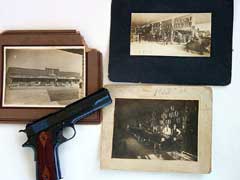
John
Everett Walker's hardware store
in Blooming Grove, Texas, 1912 and 1913.
The upper picture is from 1912 with horse drawn
carriages on display under the horse collars. The lower picture was taken in 1913 when the first
automobiles went on
display. The Colt 1911
was definitely an artifact of the horse and buggy era.
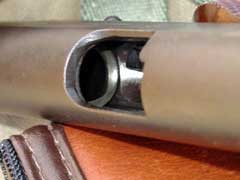
GI
model 1911's

Colt WWI Replica feed ramp. The
Colt Reproduction chamber chamfer appears somewhat more
gradual than the original military barrel but functionally, it
is the same. The
pistol will function with round nosed bullets and not abrupt
shouldered reloads.
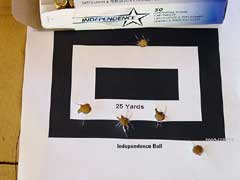
Group
fired with Independence ball ammo.
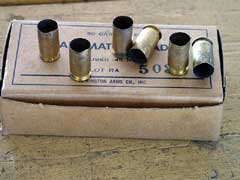
The
original 1911 port generally dings ejected brass quite badly.
Only minor distortion occurs with the sample WW1
Replica.
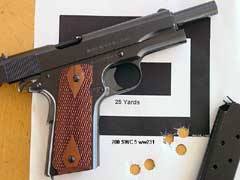
The
semi-wadcutters were prone to malfunction but produced this
2.5" 25 yard group.
Full function depends on round nosed bullets and
lead soft ball handloads should work very well.

The
extractor in the WW1 Replica is the same as used in current
series 80 pistols. Apparently,
it is interchangeable with the original type.
Other functions are basic 1911 including the true half
cock notch of the originals.

The
knurling on the hammer, slide lock and safety are redolent of
pre-World War II manufacturing techniques.
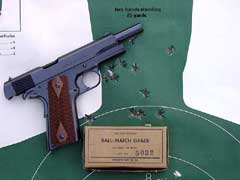
Author
shot this group standing, two handed from 28 yards while
clocking 1954 Ball and 1960 Match Ball loads.

The
WW1 Replica from Colt is a faithful copy of the original 1911
pistol . The lettering on the barrel matches that of the
original with patent dates stopping at 1913. Here it is with
the original Department of Defense Manual and screwdriver /
combination tool.
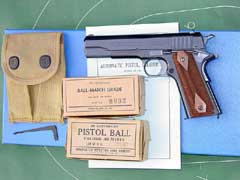
S
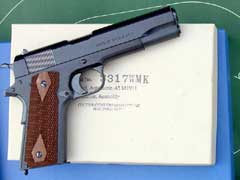
The
pistol comes in a plain cardboard box, with the pistol and a
spare magazine wrapped in waxed paper. This box comes inside a
larger blue /gold embossed box with new and original manuals
and warranty material. The entire thing is enclosed in a
sleeve.

A
B27 target shot one handed from 25 yards. The 1911 is no more
nor less capable of competent combat accuracy than the 1911A1
or subsequent variations on the theme.
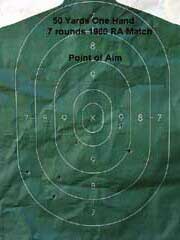
A
magazine full from 50 yards fired one-handed. Pistols have
been regarded as 50 yard weapons since the days of the Walker
Colt.
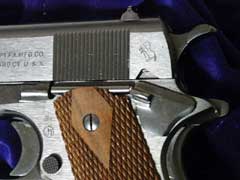
The
major features of the pre-A1 1911.
The changes introduced in 1926 were called improvements
but their value
in enhancing the shootability of the basic 1911 are debatable.
Many modern shooters find the longer trigger and flat
mainspring housing of the original preferable.
|
![]()